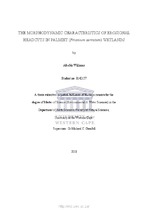| dc.description.abstract | Gully erosion and headcut migration has been at the crux of wetland degradation in South Africa. The resulting erosion and draining effect has seen more than 50% of wetlands in the country degraded. This study investigated the degradation of indigenous Palmiet, peat forming, wetlands through headcut erosion. This was done by exploring the relationship between headcut migration rate and morphodynamic characteristics through the use of multiple regression analysis. Wetlands investigated in this study occurred in the Kromme River catchment and Nuwejaars River catchment, in the Eastern Cape and Western Cape respectively. Morphodynamic characteristics assessed include headcut dimensions, gully characteristics, soil characteristics and drainage basin characteristics. These parameters were determined either through infield assessment, image analysis or laboratory analysis. Three headcut migration rate types were calculated through a combination of infield measurements and image analysis techniques executed within ArcGIS. These migration rate types include apex advancement (m/a), gully expansion (m2/a) and volume erosion (m3/a). Statistical analysis revealed significant relationships between morphodynamic characteristics and both volume erosion and gully expansion. Morphodynamic characteristics such as drop height, apex width, gully width, drainage rate and sand content were found to have a direct relationship with migration rates, whereas characteristics such as average drainage basin slope, clay content, silt content, SOM content and soil saturation were found to have an indirect relationship with headcut migration rates. Results provide insight into the headcut migration process, its influencing factors and the potential for headcut migration rate prediction. An evaluation of these results using WET-Health found that the wetland management tool captures wetland geomorphic controls to an accuracy of 68% and 70%. Furthermore, the influence of morphodynamic characteristics on migration rates contributes to the wetland rehabilitation process as it allows for the identification of headcut sites most susceptible to erosion. This will then allow for timely wetland rehabilitation, decreasing the rate of net wetland degradation and improving the management and efficiency of wetland restoration. | en_US |

